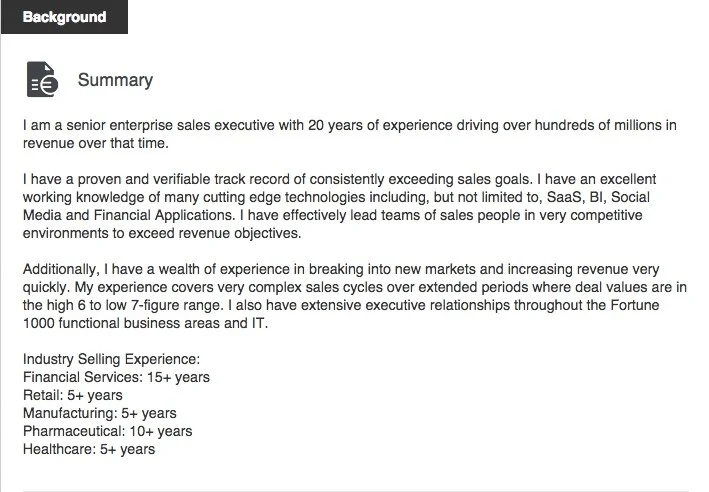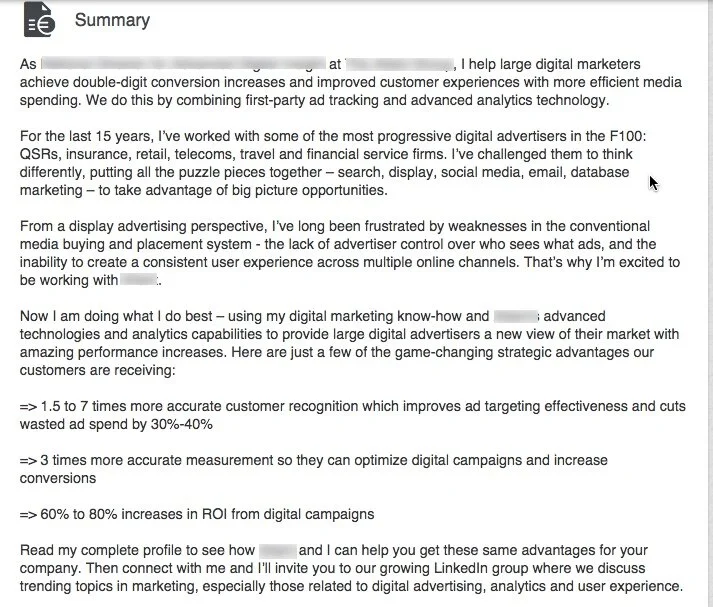Why Your LinkedIn Profile May be Driving Prospects Away
By now you’ve undoubtedly read an article or twelve about the significance of a great LinkedIn profile along with an equal number of “how to do it” articles.
But this article is different because I take a different view of profiles. The vast majority of articles and profile-writing help you’ll get (the LinkedIn profile wizard included) provide great advice and guidance for creating a solid online resume. Unfortunately, whether you’re using LinkedIn for sales or marketing, an online resume is not what you need.
Online resumes make a lousy sales tool.
A solid online resume may be better than a weak one – definitely from a job-hunting perspective; but it’s not a very good sales or marketing tool and, in some cases, it can even hurt your efforts.
For marketing people, an online resume will likely contain a bunch of information your target audiences don’t really care about. For high achieving sales people, it’s worse. An online resume can actually make your prospects run the other way.
Here’s an example of a profile summary of a sales exec I don’t know:
If I’m a recruiter looking for a sales executive in any of the listed industries, I’d probably take a closer look at the profile owner.
But you’re reading this article because you’re interested in using LinkedIn to help your prospecting efforts, and this one isn’t going to do it. That’s because the only possible benefit it might offer a prospect (“excellent working knowledge of many cutting edge technologies”) is surrounded by information touting the profile owner’s ability to sell them something they may or may not need.
Prospects aren’t going to connect with you because you’ve sold a gazillion dollars of software. Or because you won company sales star of the year for the past five years. Or because you’ve delivered triple digit increases in territory size. In fact, I suggest this information makes them less likely to connect because, at best, they don’t see how being connected to you is going to enrich their lives and, at worst, they fear they’ll be inundated with sales-y messages from that point on.
What prospects want
Prospects are going to connect with you because a) you’re interesting and b) you can help them solve a problem and do their jobs better.
Here’s an example of a sales executive who gets that:
The owner of this profile, a national sales director, makes it very clear who he helps and how he does it. He offers proof of his claims by listing benefits his customers have received while working with him and his company. He also inserts a bit of his personality by talking about what got him where he is and what excites him about his current job.
Bottom line
Your profile is the first thing prospects look at when deciding whether or not they want to have anything more to do with you. It’s as simple as that. You wouldn’t whip out your resume at an offline networking function or send it to prospects via email as a way to get to know you, so why do it on LinkedIn?
And maybe you do want to appeal to recruiters and hiring managers as well as prospects. That’s easy and I’ll write about it in a future article.
Meanwhile, you can read more about creating a powerful profile here and here. Just let me know if you have any questions.
One more thing
If you’re the owner of the profile I used as an online resume example, my apologies. Nothing personal intended. At least you have a summary, which is better than a lot of profiles out there. Contact me and I’ll brainstorm with you for free about how to make your profile work better for you.
Photo by iosphere



